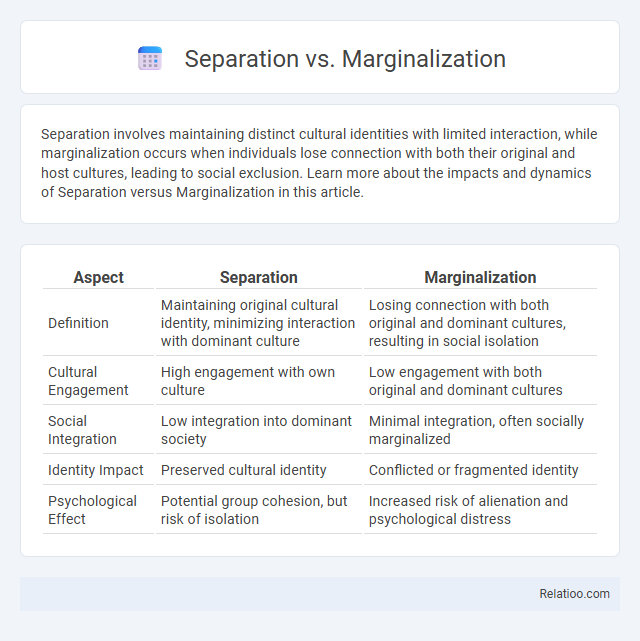Separation involves maintaining distinct cultural identities with limited interaction, while marginalization occurs when individuals lose connection with both their original and host cultures, leading to social exclusion. Learn more about the impacts and dynamics of Separation versus Marginalization in this article.
Table of Comparison
| Aspect | Separation | Marginalization |
|---|---|---|
| Definition | Maintaining original cultural identity, minimizing interaction with dominant culture | Losing connection with both original and dominant cultures, resulting in social isolation |
| Cultural Engagement | High engagement with own culture | Low engagement with both original and dominant cultures |
| Social Integration | Low integration into dominant society | Minimal integration, often socially marginalized |
| Identity Impact | Preserved cultural identity | Conflicted or fragmented identity |
| Psychological Effect | Potential group cohesion, but risk of isolation | Increased risk of alienation and psychological distress |
Understanding Separation and Marginalization
Separation occurs when individuals or groups maintain their original cultural identity while avoiding interaction with the dominant society, preserving traditions and values without adopting external influences. Marginalization happens when people lose connection with both their native culture and the dominant culture, resulting in social isolation and identity confusion. Understanding your experience with separation or marginalization is crucial for addressing challenges in cultural integration and personal identity development.
Key Definitions: Separation vs Marginalization
Separation involves maintaining one's original cultural identity while rejecting the dominant society's culture, leading to limited interaction between groups. Marginalization occurs when individuals lose connection with both their original culture and the dominant culture, resulting in social isolation and alienation. Understanding these distinct forms of cultural adaptation is essential for addressing issues in multicultural integration and identity formation.
Historical Contexts of Separation and Marginalization
Separation and marginalization represent distinct historical responses to cultural differences, where separation involves deliberately maintaining cultural identity apart from a dominant society, often seen in segregated communities or colonial administrations. Marginalization, by contrast, historically refers to the exclusion or relegation of certain groups to the social or economic periphery, evident in the systemic disenfranchisement of indigenous peoples or racial minorities. Understanding these contexts helps you recognize how power dynamics and social policies shape cultural integration and identity preservation.
Causes and Triggers of Separation
Separation occurs when individuals or groups intentionally isolate themselves from the dominant culture due to perceived threats to their identity, discrimination, or desire to preserve heritage. Triggers include social exclusion, cultural stigmatization, and policies that marginalize minority communities. These causes foster a protective environment that resists assimilation and maintains distinct cultural boundaries.
Factors Leading to Marginalization
Marginalization occurs when individuals or groups are excluded from meaningful participation in social, economic, or political life due to factors like systemic discrimination, lack of access to education, and economic disparities. Unlike separation, which involves voluntary cultural or social withdrawal, marginalization is often involuntary and results from external barriers placed on your integration and acceptance. Understanding these factors is crucial to addressing social inequities and fostering inclusive communities.
Social and Psychological Impacts Compared
Separation often leads to social isolation and heightened psychological stress due to limited interaction with the dominant culture, resulting in feelings of alienation. Marginalization can cause significant identity confusion and emotional distress as individuals feel excluded from both their original culture and the mainstream society. Your psychological well-being improves with acculturation, which promotes social integration and cultural adaptation, fostering a balanced identity and reducing stress.
Separation vs Marginalization: Case Studies
Separation involves individuals maintaining their original cultural identity while minimizing interaction with the dominant society, whereas marginalization reflects a disconnection from both the original culture and the mainstream community, leading to social isolation. Case studies reveal that individuals practicing separation often experience stronger cultural cohesion and psychological resilience compared to those facing marginalization, who may suffer from heightened stress and identity confusion. Understanding your experience within these frameworks can guide targeted support strategies to improve social integration and mental well-being.
Addressing and Mitigating Each Phenomenon
Separation involves maintaining your original cultural identity while minimizing interaction with the dominant culture, often addressed by fostering inclusive spaces that promote intercultural dialogue and understanding. Marginalization occurs when individuals feel disconnected from both their heritage and the dominant society, requiring targeted social support and community engagement programs to rebuild a sense of belonging. Acculturation, the process of adapting to a new culture while balancing original traditions, can be mitigated through educational resources and multicultural policies that encourage cultural exchange and respect.
Policy Implications: What Can Be Done?
Policies fostering inclusive integration frameworks can mitigate the adverse effects of separation and marginalization by promoting intercultural dialogue and equal access to resources. Governments should implement targeted educational programs and community engagement initiatives that support acculturation while respecting cultural identities. Providing legal protections against discrimination and facilitating economic opportunities are essential to encourage social cohesion and enhance immigrant well-being.
Building Inclusive Societies: Moving Beyond Division
Separation, marginalization, and acculturation represent distinct approaches to cultural integration that can either hinder or promote social cohesion. Building inclusive societies requires moving beyond mere coexistence by fostering environments where diverse cultural identities are respected and equally valued, reducing social divisions and inequalities. Your role in supporting policies that encourage intercultural dialogue and mutual understanding is crucial for transcending exclusion and achieving true inclusion.

Infographic: Separation vs Marginalization
 relatioo.com
relatioo.com